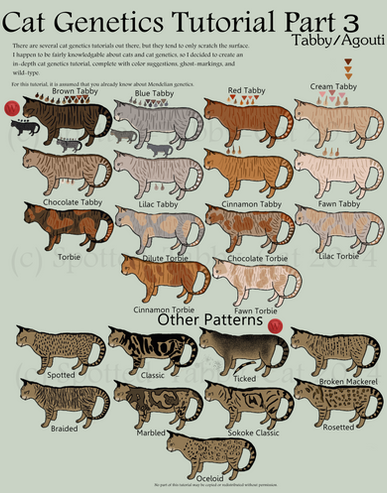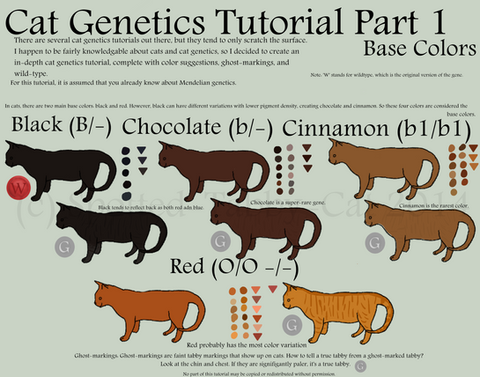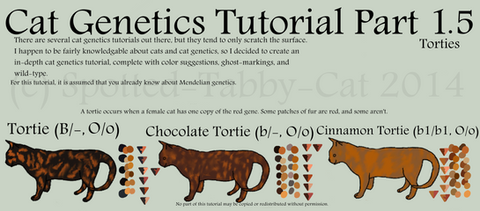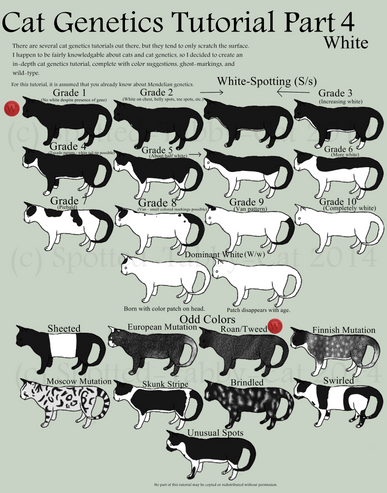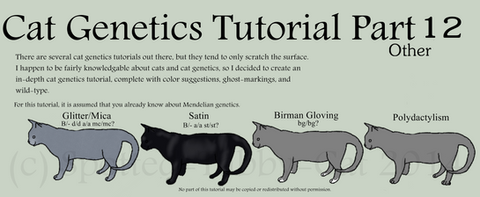HOME | DD
 Spotted-Tabby-Cat — Cat Genetics Tutorial Part 2 (Dilute Colors)
Spotted-Tabby-Cat — Cat Genetics Tutorial Part 2 (Dilute Colors)

Published: 2014-11-25 00:00:55 +0000 UTC; Views: 26204; Favourites: 189; Downloads: 180
Redirect to original
Description
This tutorial is out of date. Please see more information here .
There are multiple cat genetics tutorials about, but they tend to only cover the basics (base colors, dilutions, tabby, white-spotting, pointism, & tortie/orange). In-depth cat genetics tutorials tend to be lacking. So thus, this. I have no idea how long this will take to be completed. Hopefully before 2016.
Dilutions are next. They reduce the pigment density in the hairs, thus creating a lighter shade. Not much else to say. Ghost-markings are shown, but I forgot the 'G' that's supposed to be next to them. Hopefully you can tell which is ghost-markings and which isn't.
Key:
Colored Circle - Color variations/suggestions
Colored Triangles - Nose leather colors
Part 1 (Base Colors):
Cat Genetics Tutorial Part 1 (Base Colors)
Part 1.5 (Torties):
Cat Genetics Tutorial Part 1.5 (Torties)
Part 2 (Dilutions):
Cat Genetics Tutorial Part 2 (Dilutions)
Part 3 (Tabby):
Cat Genetics Tutorial Part 3 (Tabby/Agouti)
Part 4 (White-Spotting):
Cat Genetics Tutorial Part 4 (White)
Part 5 (Pointism & Albinism):
Cat Genetics Tutorial Part 5 (Pointism & Albinism)
Part 6 (Silver & Gold Series):
Cat Genetics Tutorial Part 6 (Silver & Gold Series)
Part 7 (Color Changes):
Cat Genetics Tutorial Part 7 (Color Changes)
Part 8 (Weirdos):
Cat Genetics Tutorial Part 8 (Weirdos)
Part 9 (Hair):
Cat Genetics Tutorial Part 9 (Hair)
Part 10 (Tail):
Cat Genetics Tutorial Part 10 (Tail)
Part 11 (Ears):
Cat Genetics Tutorial Part 11 (Ears)
Part 12 (Other):
Cat Genetics Tutorial Part 12 (Other)
Related content
Comments: 10

Now, I'm curious... my cat is a torbie. But! She seems to have a darker lilac fur base but a full-on bright red for the red portion of her tortoiseshell pattern... Any idea of how this might happen? Since she doesn't seem to be chocolate or cinnamon, but it's like a grayish-tan color.....
👍: 0 ⏩: 0

Do you mean the double dilutes? I have not made a tutorial covering that, namely for the reason that I have never seen nor seen a picture of a double dilute cat. I have also never really seen much written material on the subject. If I can find more on it, I may include it, but for now I'm not planning on doing so.
👍: 0 ⏩: 1

I don't really know about double dilutes? I've never heard the term before?
But when a cat has 'dd' genes there's a modifier gene (Dm)? I don't know if that's what you mean though.
👍: 0 ⏩: 1

I believe that we are talking about the same thing, as 'dm' is the gene I know for a double dilute.
👍: 0 ⏩: 1

Alright! I haven't found much about it either - which is why I hoped that you had something - but that's okay!! I really like your other tutorials <3
👍: 0 ⏩: 0

I love your in-depth cat genetics tutorials. In-depth cat genetics tutorials are so hard to come by.
Is there going to be a tutorial on torbies and dilute torbies, eye color, and on how white spotting affects tortoiseshell patterns?
👍: 0 ⏩: 1

Thank you. They can be pretty hard to find. If you want to learn more, I'd recommend checking out the website Messybeast.
Torbies and dilute torbies will be part of the tabby tutorial, which I am currently workings on, and white-spotting and tortoiseshell patterns will be part of the white-spotting tutorial. Unfortunately, very little research has been done into cat eye colors and how they are inherited. It is known that they are on a sliding scale from green to copper or brown in hue, with blue being caused by separate genes (like white-spotting, ojos azules, or pointism). Cats with diluted pelts tend to have paler eyes, and as cats age their eyes become a little bit paler. Other than that, and the fact that moggy (breedless) cats have dull eyes compared to pedigreed cats, I don't know any more.
👍: 0 ⏩: 1

Is there also going to be a page on the inaccurate cat patterns that often show up on cartoon (both western animation and anime), comic, manga, and picture book illustration cats so one knows how to spot the inaccurate patterns?
Examples of Inaccurate Cat Patterns in Animation and Comics
1) A black nose on a cat that isn't either a black, black-and-white, or other cat with a non-agouti black base to their fur color. Orange cats can sometimes get brown or black freckles on their noses and brown/black tabbies' noses can sometimes be brown or dark brown instead of the usual red.
2) A black nose on a dominant white or an albino cat.
3) Black stripes on a red/orange/ginger cat.
4) Tabbies with stripes on the back, back and head, head, back, and tail, or back and tail but without stripes on the legs.
5) A 100 percent solid/patternless orange or cream cat. The gene that turns off agouti doesn't work well on the orange gene. An orange or cream cat can come close though.
6) A white spotted cat that appears all white but with colored paws and/or color on entire belly/underside.
7) A white spotted cat with white on the entire belly and/or entire chest with or without a white muzzle that doesn't have white paws. A cat can have locket or button markings without white paws though.
👍: 0 ⏩: 1

I hadn't planned on doing anything like that, but I'll consider it. Some of it will be covered (6&7 in white-spotting for example). And hopefully people will be able to gather nose colors with the nose leather suggestions.
👍: 0 ⏩: 0

